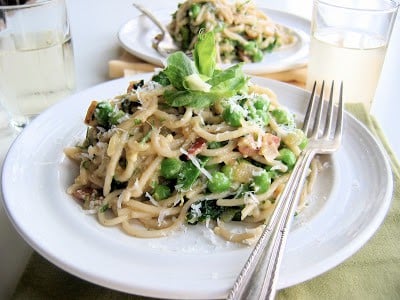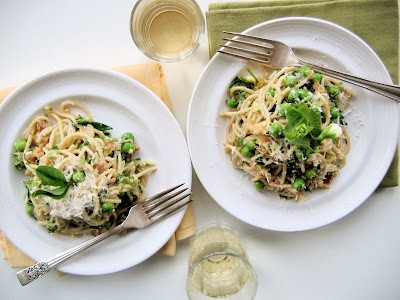
While studying Italian language at UCSC, I fell in love. I loved rolling my Rs, I loved saying chiacchierare (to chat), I loved my adorable professor and her equally awesome name, Maria Antonella Principe De Chicchio (which I also loved to say). I even came to tolerate the subjunctive tense.
But I loved biscotti, tiramisù, and gelato.Therefore, when I spent my junior year in Bologna, I expected to fall in love with Italy and its citizens, too.
I found a room for rent in a small apartment in the center of town. The place had a 7 1/2 floor feeling about it, and while I'm of average height, I had to duck when walking through any of the doorways. My room didn't have a real door, but rather a sort of sliding screen, and the bathroom contained neither a shower nor a bath, but a hybrid: a tiny basin with a seat and a removable shower head (but it did have a bidet, certo).
I did adore my three Italian housemates, but I often found myself baffled by our cultural differences.Christiana ate milk and cereal with a shot of espresso in it for breakfast.Luisa swore by her Italian tarot cards.Deborah chain-smoked in the living room with all the windows closed. And the household kept the salt and sugar in identical, un-labeled containers so that one had to taste the contents each time one wished to season one's food or drink.
One day, I wandered into the hobbit-sized kitchen to discover two of them eating plain pasta dressed with nothing but a bit of olive oil. This was not merely the Italians' famed gastronomical minimalism; the girls informed me that they were in dieta. Puzzled, I asked why they didn't add some vegetables to their 'diet food.' They looked horrified. 'Troppo pesante!' they scolded. Too heavy!
I watched as they resolutely ate plain white pasta and risotto for lunch and dinner, day after day. It was unclear to me whether the diet had the desired effect. But weight loss or no, I still consider vegetables a necessary part of any (and every) meal.
I know it's cruel to even mention the word 'diet' in a post containing eggs, pasta, two kinds of cheese and bacon. But as I packed more and more vegetable matter into this traditionally sparse dish, I couldn't help wondering what Deborah and Luisa would think of me.
Pasta alla carbonara typically contains just a handful of ingredients: spaghetti or bucatini cooked until al dente and tossed with crisped bacon, peas, and beaten eggs. The thought of pouring raw eggs over my pasta repulsed me, too, until I tasted the finished dish: the heat from the pasta coddles the eggs into a voluptuous sauce. If you use eggs from happy chickens, the finished dish will taste happier, too.
Inspired by the handsome photo in The Zuni Cafe Cookbook, and the less standard recipe in Sunday Suppers at Lucqueswhich calls for ricotta and sauteed onions, I made several batches of this pasta until it tasted just right to my American palate. With plenty of fresh peas and pea greens, as well as onions, garlic and parsley, this pasta makes a nourishing one-dish meal. If you want to be really gluttonous, serve it with a crisp, green salad.
Just don't invite any Italians.
For more pasta recipes:
- Cheesy Baked Pasta with Chard {gluten-free}
- Nettle Pesto Pasta with Sun-Dried Tomatoes
- Creamy Cardoon Mac and Cheese {gluten-free}
- Baked Penne with Eggplant and Fontina
*Bojon appétit! For more Bojon Gourmet in your life, follow along on Instagram, Facebook, or Pinterest, purchase my gluten-free cookbook Alternative Baker, or subscribe to receive new posts via email. And if you make this pasta alla carbonara recipe, I’d love to know. Leave a comment and rating below, and tag your Instagram snaps @The_Bojon_Gourmet and #bojongourmet.*

Pasta Alla Carbonara
Print Recipe Pin RecipeIngredients
- 8 ounces dry pasta (see note)
- salt
- 2 large eggs
- 1 tablespoon olive oil
- 3 ounces bacon, sliced into 1/2" pieces (3 thick-cut or 4 thinner-cut rashers)
- 1 large spring onion, diced (or a smallish yellow onion)
- 1 stalk of green garlic, finely chopped (or 1 clove of mature garlic)
- 1/4 cup ricotta cheese
- 1/2 cup freshly grated parmesan, plus more for topping the pasta
- freshly ground black pepper
- 2 - 3 ounces pea greens, roughly chopped (about 2 cups)
- 1 pound pea pods, shelled to make 1 cup peas
- a few tablespoons chopped Italian parsley
Instructions
- Put on a pot of water for the pasta, and salt it heavily.
- If your eggs have been refrigerated, place the whole, un-cracked eggs in a medium bowl and fill it with warm tap water to bring them to room temperature.
- Warm the olive oil in a wide skillet over medium heat. Add the bacon and cook, stirring occasionally, until lightly crisped, 5 minutes. Add the onion and garlic and cook, stirring occasionally, until the onion is very tender and lightly golden, 10 minutes.
- While the onion is cooking, put the pasta in the boiling water and cook, stirring occasionally to prevent stickage, until al dente (if the pasta is overcooked, it will fall apart when you toss it with the sauce, so try not to do that).
- Meanwhile, whisk together the eggs, ricotta, parmesan, 1/2 teaspoon salt and a few solid turns of pepper in a medium bowl until combined. Set aside.
- While the pasta cooks, add the pea greens to the onion mixture and saute until wilted and tender, a minute or two. Add the peas and cook for one minute, then remove from the heat.
- When the pasta is done, drain it well and add it to the skillet (if your skillet is big enough, if not, put everything in the pasta pot instead). Pour the egg mixture over the pasta and veg, and toss it all together with tongs. Ideally, the egg cooks to a thick, creamy sauce from the heat of the pasta and veg; if the egg seems undercooked, place the skillet over medium-low heat and toss the mixture constantly until the egg thickens. Toss in the chopped parsley.
- Serve the pasta immediately, with a good grating of parmesan.
Notes
Nutrition
Makes 4 medium-sized servings
Inspired by The Zuni Cafe Cookbook and Sunday Suppers at Lucques
Spaghetti and bucatini are the classic pasta choices for this dish, but penne and orecchiette work well, too. This makes some very saucy pasta; for a more spare, Italian-style dish, increase the pasta to 12 ounces, and reserve a splash of pasta water to add the the finished dish if it seems dry. Pea greens are sometimes called 'pea shoots' or 'tendrils;' if you can't find them, omit them, or throw in some baby spinach leaves or arugula with the peas, if you like. I'm guessing you could omit the ricotta if you didn't have any. Enjoy with a crisp white wine.
8 ounces dry pasta (see note)
salt
2 large eggs
1 tablespoon olive oil
3 ounces bacon (3 thick-cut or 4 thinner-cut rashers), sliced into 1/2" pieces
1 large spring onion (or a smallish yellow onion), diced
1 stalk of green garlic (or 1 clove of mature garlic) finely chopped
1/4 cup ricotta cheese
1/2 cup freshly grated parmesan, plus more for topping the pasta
freshly ground black pepper
2 - 3 ounces (about 2 cups) pea greens, roughly chopped
1 pound pea pods, shelled to make 1 cup peas
a few tablespoons chopped Italian parsley
Put on a pot of water for the pasta, and salt it heavily.
If your eggs have been refrigerated, place the whole, un-cracked eggs in a medium bowl and fill it with warm tap water to bring them to room temperature.
Warm the olive oil in a wide skillet over medium heat. Add the bacon and cook, stirring occasionally, until lightly crisped, 5 minutes. Add the onion and garlic and cook, stirring occasionally, until the onion is very tender and lightly golden, 10 minutes.
While the onion is cooking, put the pasta in the boiling water and cook, stirring occasionally to prevent stickage, until al dente (if the pasta is overcooked, it will fall apart when you toss it with the sauce, so try not to do that).
Meanwhile, whisk together the eggs, ricotta, parmesan, 1/2 teaspoon salt and a few solid turns of pepper in a medium bowl until combined. Set aside.
While the pasta cooks, add the pea greens to the onion mixture and saute until wilted and tender, a minute or two. Add the peas and cook for one minute, then remove from the heat.
When the pasta is done, drain it well and add it to the skillet (if your skillet is big enough, if not, put everything in the pasta pot instead). Pour the egg mixture over the pasta and veg, and toss it all together with tongs. Ideally, the egg cooks to a thick, creamy sauce from the heat of the pasta and veg; if the egg seems undercooked, place the skillet over medium-low heat and toss the mixture constantly until the egg thickens. Toss in the chopped parsley.
Serve the pasta immediately, with a good grating of parmesan.













rcakewalk says
I thinned out my peas yesterday, something I've never done before, but figured the backs of the seed packets knew best. I kept all of the thinned pea shoots, about the size of yours in the photos... and now I totally want this! I have made carbonara, but not in a long while and never with peas. I only have a few shoots left, and all the markets are late here, but I will try this when able.
And, cereal with espresso? Wonder if she also poured salt on it by accident ;)
Amelia says
Made a vegetarian, dairy free and wheat free version today and I have to say it couldn't be any less delicious than the meaty, cheesy, wheaty recipe. I used sauteed mushrooms instead of bacon, brown rice pasta instead of standard, and just omitted the ricotta and parm. The eggs still did their job of adding creamy richness and I know I will be making versions of this over and over again. Thanks Alanna!
Alanna says
Rebecca- I'm fairly certain that she did. ; ) I'm envious of your pea-growing skillz!
Amelia - that is awesome!! I usually use brown rice pasta, too - I've even come to like it better than the wheaty stuff.